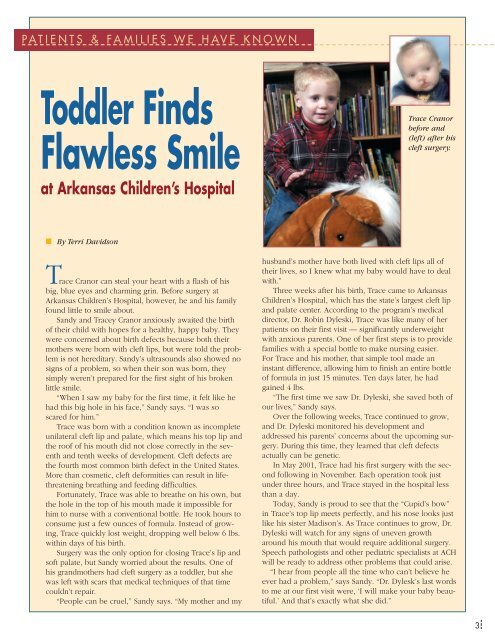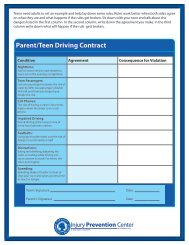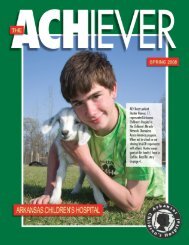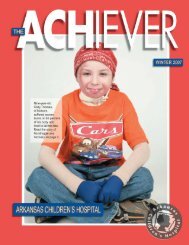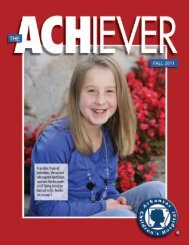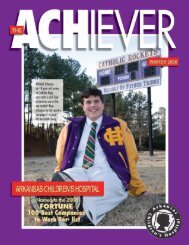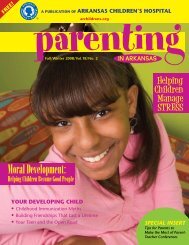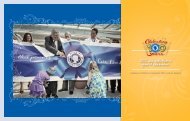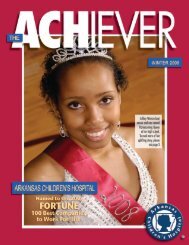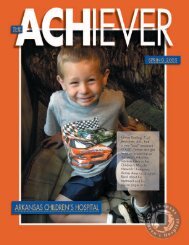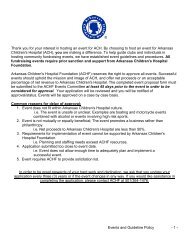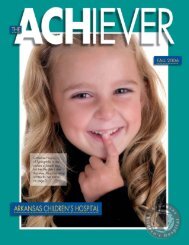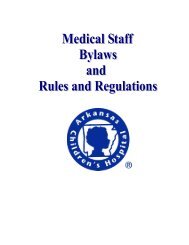facing life with a smile - Arkansas Children's Hospital
facing life with a smile - Arkansas Children's Hospital
facing life with a smile - Arkansas Children's Hospital
- No tags were found...
You also want an ePaper? Increase the reach of your titles
YUMPU automatically turns print PDFs into web optimized ePapers that Google loves.
PATIENTS & FAMILIES WE HAVE KNOWNToddler FindsFlawless SmileTrace Cranorbefore and(left) after hiscleft surgery.at <strong>Arkansas</strong> Children’s <strong>Hospital</strong>■ By Terri DavidsonTrace Cranor can steal your heart <strong>with</strong> a flash of hisbig, blue eyes and charming grin. Before surgery at<strong>Arkansas</strong> Children’s <strong>Hospital</strong>, however, he and his familyfound little to <strong>smile</strong> about.Sandy and Tracey Cranor anxiously awaited the birthof their child <strong>with</strong> hopes for a healthy, happy baby. Theywere concerned about birth defects because both theirmothers were born <strong>with</strong> cleft lips, but were told the problemis not hereditary. Sandy’s ultrasounds also showed nosigns of a problem, so when their son was born, theysimply weren’t prepared for the first sight of his brokenlittle <strong>smile</strong>.“When I saw my baby for the first time, it felt like hehad this big hole in his face,” Sandy says. “I was soscared for him.”Trace was born <strong>with</strong> a condition known as incompleteunilateral cleft lip and palate, which means his top lip andthe roof of his mouth did not close correctly in the seventhand tenth weeks of development. Cleft defects arethe fourth most common birth defect in the United States.More than cosmetic, cleft deformities can result in <strong>life</strong>threateningbreathing and feeding difficulties.Fortunately, Trace was able to breathe on his own, butthe hole in the top of his mouth made it impossible forhim to nurse <strong>with</strong> a conventional bottle. He took hours toconsume just a few ounces of formula. Instead of growing,Trace quickly lost weight, dropping well below 6 lbs.<strong>with</strong>in days of his birth.Surgery was the only option for closing Trace’s lip andsoft palate, but Sandy worried about the results. One ofhis grandmothers had cleft surgery as a toddler, but shewas left <strong>with</strong> scars that medical techniques of that timecouldn’t repair.“People can be cruel,” Sandy says. “My mother and myhusband’s mother have both lived <strong>with</strong> cleft lips all oftheir lives, so I knew what my baby would have to deal<strong>with</strong>.”Three weeks after his birth, Trace came to <strong>Arkansas</strong>Children’s <strong>Hospital</strong>, which has the state’s largest cleft lipand palate center. According to the program’s medicaldirector, Dr. Robin Dyleski, Trace was like many of herpatients on their first visit — significantly underweight<strong>with</strong> anxious parents. One of her first steps is to providefamilies <strong>with</strong> a special bottle to make nursing easier.For Trace and his mother, that simple tool made aninstant difference, allowing him to finish an entire bottleof formula in just 15 minutes. Ten days later, he hadgained 4 lbs.“The first time we saw Dr. Dyleski, she saved both ofour lives,” Sandy says.Over the following weeks, Trace continued to grow,and Dr. Dyleski monitored his development andaddressed his parents’ concerns about the upcoming surgery.During this time, they learned that cleft defectsactually can be genetic.In May 2001, Trace had his first surgery <strong>with</strong> the secondfollowing in November. Each operation took justunder three hours, and Trace stayed in the hospital lessthan a day.Today, Sandy is proud to see that the “Cupid’s bow”in Trace’s top lip meets perfectly, and his nose looks justlike his sister Madison’s. As Trace continues to grow, Dr.Dyleski will watch for any signs of uneven growtharound his mouth that would require additional surgery.Speech pathologists and other pediatric specialists at ACHwill be ready to address other problems that could arise.“I hear from people all the time who can’t believe heever had a problem,” says Sandy. “Dr. Dylesk’s last wordsto me at our first visit were, ‘I will make your baby beautiful.’And that’s exactly what she did.”3


